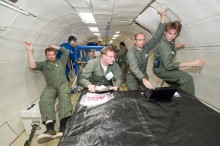Members Login

Channels
Special Offers & Promotions
Malvern Spraytec excels in zero gravity testing of new fire extinguisher for International Space Station
 ADA Technologies (Littleton, Colorado, USA) recently confirmed that both NASA's new space-bound fire extinguisher and the Spraytec laser diffraction spray particle size analyzer from Malvern Instruments function in zero gravity just as well as they do on Earth. By carrying out droplet size distribution experiments on the infamous ‘vomit comet', Zero Gravity Corporation aircraft, ADA and NASA researchers have shown that water atomization is independent of gravity and the Fine Water Mist portable fire extinguisher (PFE) currently under development for use on the International Space Station (ISS) will put out fires in space safely and cleanly.
ADA Technologies (Littleton, Colorado, USA) recently confirmed that both NASA's new space-bound fire extinguisher and the Spraytec laser diffraction spray particle size analyzer from Malvern Instruments function in zero gravity just as well as they do on Earth. By carrying out droplet size distribution experiments on the infamous ‘vomit comet', Zero Gravity Corporation aircraft, ADA and NASA researchers have shown that water atomization is independent of gravity and the Fine Water Mist portable fire extinguisher (PFE) currently under development for use on the International Space Station (ISS) will put out fires in space safely and cleanly. "Malvern's Spraytec is designed to make droplet size distribution testing as easy as possible, and was the ideal solution for testing ADA's new PFE under microgravity conditions," said project leader, ADA's Thierry Carriere. "The laser diffraction measurement system is automatically triggered when the first particles or droplets in an airborne plume are detected. This means the entire experimental setup could be automated and protected from floating scientists as the NASA aircraft flew through more than 40 parabolic trajectories delivering variable gravity levels between 0G (space) and 1.8G. In fact, the Spraytec proved to be so robust that no instrument realignments were required!"
To reduce ISS crew exposure to carbon dioxide (CO2) toxicity during fire response and post-fire cleanup, NASA funded ADA Technologies to develop a non-CO2-based PFE. To carry out this project, Carriere teamed up with Andrew Brewer, Jim Butz, and Norm Haberkorn from ADA Technologies, Angel Abbud-Madrid and Cameron Emerson from the Colorado School of Mines Centre for Space Resources, and Amber Abbott, John Easton and Justin Niehaus from the NASA Glenn Research Center (Cleveland, OH).
Carriere continued; "NASA asked us to develop a fire extinguisher that is safe to use without personal protection equipment, is capable of extinguishing both rack [hidden] and open cabin fires, and will not damage the Space Station if discharged. A Fine Water Mist PFE meets these criteria, but there was no previous evidence to demonstrate that an extinguisher of this type would perform to expectations in the zero gravity environment of the ISS. Thanks to NASA'sFlight Opportunities program, which provides access to the Reduced-Gravity Parabolic Flights, we were able to demonstrate that it could."
Malvern's Spraytec is specifically designed to address the unique requirements of spray particle and droplet characterization across a wide range of industries and applications. The Spraytec provides in-situ, robust, real-time droplet size measurements, giving accurate, reproducible results time and again.
For further information visit: www.malvern.com/spraytec
Media Partners


